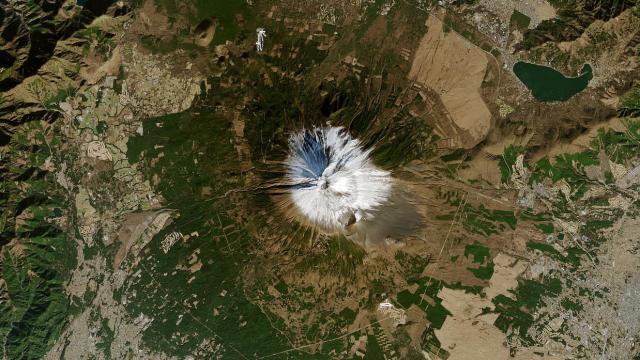Don’t look. Mount Fuji is naked. The iconic volcano is usually known for having a cap of bright white snow from autumn through spring, but this year, it’s largely missing.
The mountain is off to its lightest snowy season on the satellite record. The season’s first flakes landed on Sept. 28, 2020 covering the mountaintop with a light dusting, but that quickly melted, leaving the mountain bare. It then snowed again in late December, when Fuji got another snowcap.
But according to NASA’s Earth Observatory, “even chillier January weather did not guarantee that the snow cap would last.” It mostly disappeared within a few days due to above-freezing temperatures and wind, which blew some coverage away. Shocking Landsat-8 images show just how weird this year is compared to normal.
A La Niña formed in the eastern tropical Pacific in the latter half of 2020. The climate pattern is marked by cooler-than-normal waters in that region, the effects of which ripple through the atmosphere. Japan typically is colder than normal during La Niña years, a key ingredient for snowfall. Heavy snowfall has dominated Japan’s west coast. Mount Fuji is in east Japan, and hasn’t seen much at all, though. An analysis using NASA’s Terra satellite shows the mountain’s December snow cover was the lowest in 20 years of record keeping.
But La Niña isn’t the only factor that can affect the climate of Japan. And this isn’t just one weird year, either. Fuji is trending toward less predictable climate conditions overall. In 2019, it didn’t see its first snow until Oct. 23, which is about a month later than usual. In a recent study, Japanese scientists found that the tree line climbed up the mountain’s flanks by about 30.5 metres over the last four decades. That was likely tied to an increase in summer temperatures at Fuji’s peak by 2 degrees Celsius.
So the future’s not looking good for Fuji’s snowcap, nor is the forecast for the rest of this year. The Japan Meteorological Agency is forecasting that while cooler-than-normal temperatures are likely across much of the country through March, the snowfall pattern we’ve seen to-date will persist.
